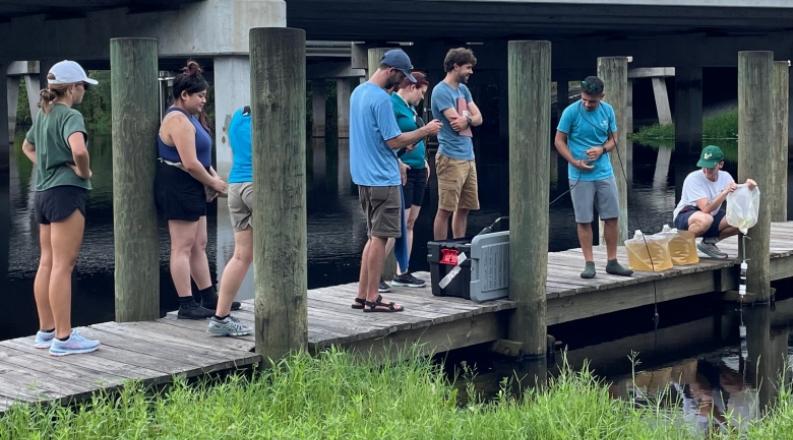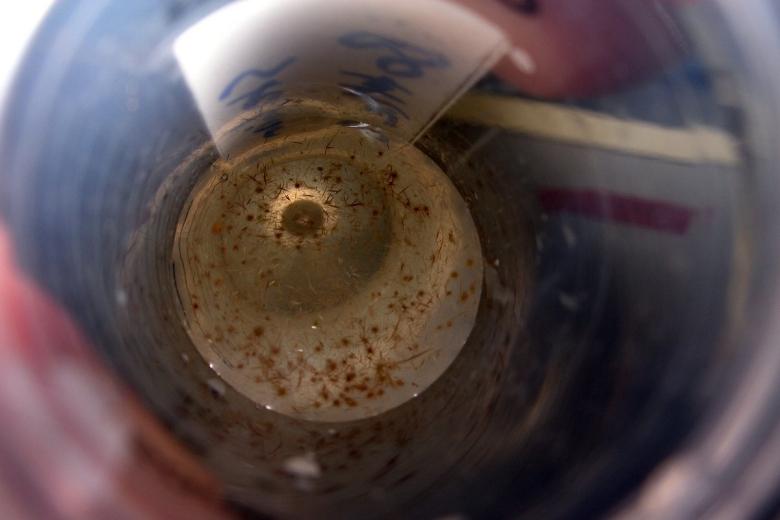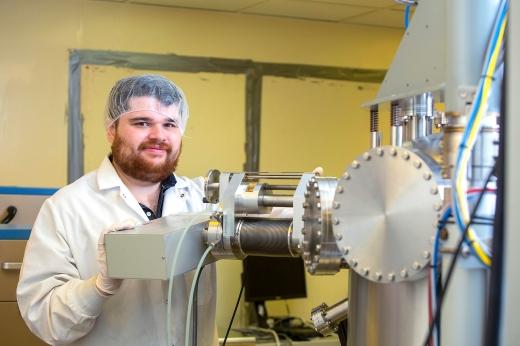Co-PI’s, Old Dominion University’s Associate Professor Dreux Chappell, ODU’s Assistant Professor Joe Tamborski and Oregon State University’s Assistant Professor Rene Boiteau, along with graduate students, measuring biogeochemical parameters of the Hillsborough River, as part of a team inter-calibration and training exercise.
This is a photo of phytoplankton known as Trichodesmium, which thrives in the West Florida Shelf.
By Tiffany Whitfield
Department of Ocean and Earth Sciences Associate Professor Dreux Chappell and Assistant Professor Joe Tamborski plus a team of researchers from around the country have received a $2.3 million award from the National Science Foundation (NSF) to investigate an oceanographic mystery in the waters west of St. Petersburg, Florida.
The area, known as the West Florida Shelf, is considered an ocean desert because it is cut off from deep ocean circulation that brings many of the nutrients and elements that are essential for ocean plants. Yet in this nutrient-deficient region, some forms of phytoplankton, the microscopic marine plants suspended in water, are thriving and supporting higher forms of life. How is this possible?
Chappell, Tamborski and their collaborative team led by Associate Professor Angela Knapp of Florida State University will examine how iron and nitrogen carried by submarine groundwater discharge might serves as a fertilizer for phytoplankton in this area and beyond.
Chappell's group will use molecular methods to characterize the abundance and gene expression of the phytoplankton in addition to performing biological rate measurements of key phytoplankton metabolic processes active on the shelf.
"I'm particularly interested in exploring the biological availability of different forms and sources of nutrients to phytoplankton, which is exactly what this type of collaborative effort is designed to explore," Chappell said.
Tamborski's group will measure naturally occurring isotopes of the element radium as tracers of submarine groundwater flow entering the West Florida Shelf to quantify nitrogen and iron loads. Submarine groundwater discharge is an ubiquitous hydrological process characterized by the flow of fresh and brackish water from land into the sea. The amount is poorly known, but can play an important role in moving nutrients, trace elements and gases throughout ocean waters that can then be used by phytoplankton.
"The West Florida Shelf is a broad carbonate platform that groundwater can easily flow through, much like Swiss cheese, flowing miles offshore as fresh and saline springs," Tamborski said. "Using naturally occurring Ra isotopes, we will be able to identify and quantify submarine groundwater discharge along the shelf to assess the importance of this 'invisible' pathway for nitrogen and iron in this ocean desert environment."
The research team will combine a diverse array of chemical and biological analyses to extract information from water samples collected at various depths on the West Florida Shelf and other areas of the Gulf of Mexico to identify the unique chemistry associated with submarine groundwater discharge, including molecular and isotopic composition of dissolved iron and nitrogen. This "geochemical signature" derived from the chemical analyses will focus on characterizing the nutrients consumed by phytoplankton and their significance.
"Plant growth in the ocean plays an important role in regulating atmospheric carbon dioxide concentrations, which plays an important role in regulating climate," Knapp said. "However, plant growth in the ocean is often limited by the availability of nitrogen; thus, we're focusing on the processes that add and remove nitrogen to and from the ocean."
Examining the distribution of particular isotopes in the samples allows scientists to track the distance submarine groundwater nutrients travel into the Gulf of Mexico and Atlantic Ocean.
While nitrogen and phosphorous - found in proteins, enzymes and DNA - are essential elements for all forms of life, the nutrient-depleted areas of the West Florida Shelf contain relatively low concentrations of these elements.
Without iron and phosphorous, phytoplankton growth should be limited, posing a significant challenge to ocean life, as the microscopic plants form the base of the marine food web. The effects of limited phytoplankton growth cascade through the ecosystem and affect the abundance and diversity of fish, sharks, whales and more.
Chappell and Tamborski will lead teams of graduate students on several cruises as part of this collaborative group of researchers. The project includes several educational components, including the development of activities for K-12 students geared toward increasing awareness of the roles that nutrient fluxes and marine algal growth play in regulating global climate. Additionally, undergraduate students will participate in the research.
In addition to ODU faculty and graduate students, researchers from several other institutions including, FSU, the University of South Florida, Oregon State University, and the United States Geological Survey office in St. Petersburg, will also contribute to this project.
Related News Stories
ODU’s MathFest will Run Through Labor Day Weekend
The event challenges students in grades 3 to 8 in an educational exercise at several locations in Hampton Roads. (More)
Modeling Excellence for 25 Years
Old Dominion University’s Virginia Modeling, Analysis and Simulation Center to celebrate its silver anniversary. (More)
ODU Doctoral Student Earns Global Recognition
Benjamin Belfore, a newly minted Ph.D. in electrical engineering, devised the world’s second-best spin polarized photocathode. (More)







